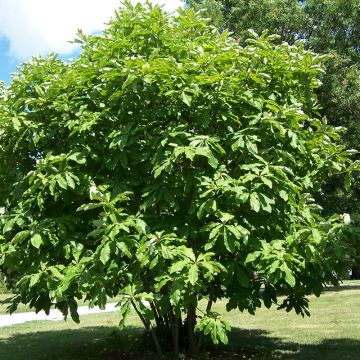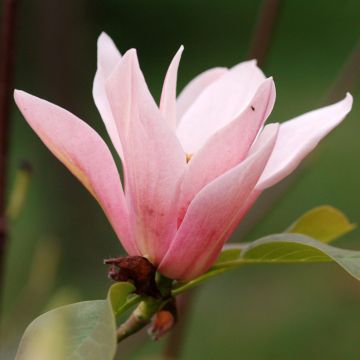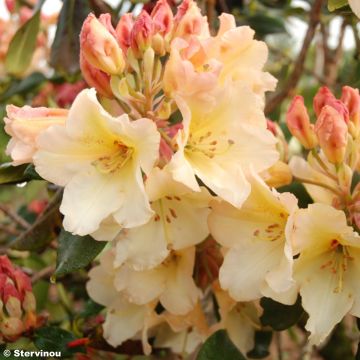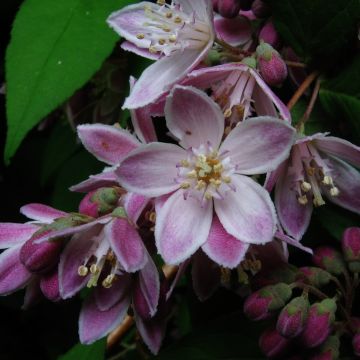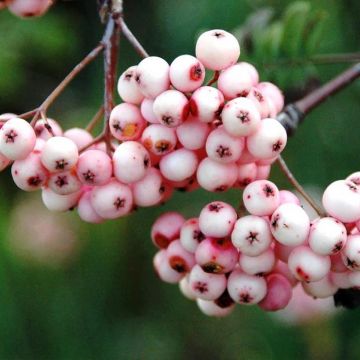

Magnolia soulangeana Emperor


Magnolia soulangeana Emperor


Magnolia soulangeana Emperor
Magnolia soulangeana Emperor
Magnolia x soulangeana Emperor
Magnolia
First bloom, March 2024
Richard , 15/03/2024
This item cannot be shipped to the selected country
Oversize package delivery charge from €6.90
Delivery to Corse prohibited
More information
Schedule delivery date,
and select date in basket
This plant carries a 24 months recovery warranty
More information
We guarantee the quality of our plants for a full growing cycle, and will replace at our expense any plant that fails to recover under normal climatic and planting conditions.
Oversize package: home delivery by special carrier from €6.90 per order..
Express home delivery from €8.90.
Delivery to Corse prohibited: UE law prohibits the import of this plant from mainland France to Corse as part of the fight against Xylella fastidiosa. Please accept our sincere apologies.
More information
Does this plant fit my garden?
Set up your Plantfit profile →
Description
Magnolia x soulangeana 'Emperor' is a unique hybrid Magnolia with its large flowers and perpetual flowering in summer. Its extraordinary flowers, of a dreamy dark pink, first bloom in spring on its naked branches, and then again in summer amoungst the foliage. Unforgettable, like all flowering magnolias, this one may be even more so. Hardy and easy to grow in any good non-alkaline garden soil, this wonderful small tree also adapts to container cultivation for a few years.
The 'Emperor' Magnolia, from the magnolia family, is a recent horticultural selection made in New Zealand. One of its parents, the Magnolia x soulangeana, is the origin of a magnificent lineage of cultivars. This hybrid is the result of cross-breeding between Magnolia denudata and M. liliflora, two Asian species. 'Emperor' first presents a pyramidal habit, then its crown becomes rounded over time. It slowly forms a large bush or a small tree with a rounded and spreading habit, taller than it is wide. It reaches an average height of 5 meters (16 feet) and a width of 3.5 meters (11 feet) at ten years old. The leaves, 10 to 15 cm (4 to 6in) long, have a rounded and slightly pointed tip. Deciduous, the dark green foliage, paler and finely hairy on the underside, turns yellow-brown in autumn before falling. From March to May, depending on the region, and again in June-July, its immense solitary cup-shaped flowers of dark pink color appear. Erect, they open from buds protected by velvety bracts, and are formed by 9 waxy and thick tepals (undifferentiated sepals and petals), measuring up to 30 cm (12 in) long. Opening widely, the 20 cm (8 in) diameter flower reveals a center occupied by numerous reddish-brown stamens. This is followed by red to brown fruits in the shape of cylindrical cones, containing red seeds. The longevity of the Magnolia x soulangeana can exceed one hundred years.
This 'Emperor' Magnolia enhances this small tree that we have all admired at some point. It will work wonders in both medium-sized gardens and large parks. Among the most accommodating, it shows great generosity in any good deep, moist, and non-alkaline garden soil. It is most often used as a solitary specimen in the middle of a short grass meadow, where it outshines all other plants from early spring to the heart of summer. To accompany it, consider other bushes such as mock oranges, lilacs, beautybushes, botanical roses, and many others. The 'Emperor' Magnolia can also be combined with a mass planting of acid-loving shrubs (Rhododendrons, Camellias, Hydrangeas, Pieris, Daphnes...) for a Japanese-style garden. Note that the Magnolia x soulangeana is one of the ornamental trees that best withstand atmospheric pollution.
Report an error about the product description
Magnolia soulangeana Emperor in pictures


Plant habit
Flowering
Foliage
Botanical data
Magnolia
x soulangeana
Emperor
Magnoliaceae
Magnolia
Cultivar or hybrid
Other Magnolia
Planting and care
The Magnolia x soulangeana 'Emperor' prefers sheltered positions, sunny to partially shaded exposures, a moist to humid, well-drained, rich and humus-rich soil, deep, neutral to acidic. It tolerates clayey and slightly alkaline soils, not waterlogged. However, it does not tolerate excess lime, poor and dry soils, or windy locations. It enjoys good hardiness, but it is essential to protect young subjects from frost in the first years following planting. Note that late frosts and cold wind can damage flower buds and young leaves, thus affecting flowering.
Magnolia can be planted in spring or autumn, outside the frost period, ensuring it is installed sheltered from cold winds. Prepare a hole, 80 cm (32 in) on each side and as deep, with a good supply of ericaceous compost. Be careful when placing it in the hole, so as not to break the fleshy but fragile roots. Immediate watering with non-lime water (rainwater) helps to settle the soil around the roots. During the first year of planting, Magnolia requires watering once a week. It will appreciate a mulch once a year in spring. For planting in alkaline soil, it will be necessary to replace or amend your soil with pine bark, leaf compost, and ericaceous compost.
For better establishment of your tree, do not choose plants that are too large (1.50 m (5ft) is a good size). Staking may be necessary if the tree is a large specimen. Water generously in the early years. Since the Magnolia does not tolerate prolonged drought, the soil should remain slightly moist (but not waterlogged) throughout the summer. It is recommended to mulch the base to retain moisture during the hot season, enrich the soil, and protect it from the cold in winter. During the first years, pruning after flowering can be done to shape its silhouette. The growth of this tree is slow in the first years after planting. It will be well established after 4 to 5 years, its growth will accelerate, and pruning will no longer be necessary, except for removing dead wood and rebalancing its habit. Since its roots are fragile, transplanting should be avoided. The only enemies of Magnolia are pests such as scale insects, snails, and slugs that attack young plants, and diseases such as root rot (in excessively waterlogged soil), coral disease, and Pestalozzia.
Planting period
Intended location
Care
-
, onOrder confirmed
Reply from on Promesse de fleurs
Spring-flowering shrubs
Haven't found what you were looking for?
Hardiness is the lowest winter temperature a plant can endure without suffering serious damage or even dying. However, hardiness is affected by location (a sheltered area, such as a patio), protection (winter cover) and soil type (hardiness is improved by well-drained soil).

Photo Sharing Terms & Conditions
In order to encourage gardeners to interact and share their experiences, Promesse de fleurs offers various media enabling content to be uploaded onto its Site - in particular via the ‘Photo sharing’ module.
The User agrees to refrain from:
- Posting any content that is illegal, prejudicial, insulting, racist, inciteful to hatred, revisionist, contrary to public decency, that infringes on privacy or on the privacy rights of third parties, in particular the publicity rights of persons and goods, intellectual property rights, or the right to privacy.
- Submitting content on behalf of a third party;
- Impersonate the identity of a third party and/or publish any personal information about a third party;
In general, the User undertakes to refrain from any unethical behaviour.
All Content (in particular text, comments, files, images, photos, videos, creative works, etc.), which may be subject to property or intellectual property rights, image or other private rights, shall remain the property of the User, subject to the limited rights granted by the terms of the licence granted by Promesse de fleurs as stated below. Users are at liberty to publish or not to publish such Content on the Site, notably via the ‘Photo Sharing’ facility, and accept that this Content shall be made public and freely accessible, notably on the Internet.
Users further acknowledge, undertake to have ,and guarantee that they hold all necessary rights and permissions to publish such material on the Site, in particular with regard to the legislation in force pertaining to any privacy, property, intellectual property, image, or contractual rights, or rights of any other nature. By publishing such Content on the Site, Users acknowledge accepting full liability as publishers of the Content within the meaning of the law, and grant Promesse de fleurs, free of charge, an inclusive, worldwide licence for the said Content for the entire duration of its publication, including all reproduction, representation, up/downloading, displaying, performing, transmission, and storage rights.
Users also grant permission for their name to be linked to the Content and accept that this link may not always be made available.
By engaging in posting material, Users consent to their Content becoming automatically accessible on the Internet, in particular on other sites and/or blogs and/or web pages of the Promesse de fleurs site, including in particular social pages and the Promesse de fleurs catalogue.
Users may secure the removal of entrusted content free of charge by issuing a simple request via our contact form.
The flowering period indicated on our website applies to countries and regions located in USDA zone 8 (France, the United Kingdom, Ireland, the Netherlands, etc.)
It will vary according to where you live:
- In zones 9 to 10 (Italy, Spain, Greece, etc.), flowering will occur about 2 to 4 weeks earlier.
- In zones 6 to 7 (Germany, Poland, Slovenia, and lower mountainous regions), flowering will be delayed by 2 to 3 weeks.
- In zone 5 (Central Europe, Scandinavia), blooming will be delayed by 3 to 5 weeks.
In temperate climates, pruning of spring-flowering shrubs (forsythia, spireas, etc.) should be done just after flowering.
Pruning of summer-flowering shrubs (Indian Lilac, Perovskia, etc.) can be done in winter or spring.
In cold regions as well as with frost-sensitive plants, avoid pruning too early when severe frosts may still occur.
The planting period indicated on our website applies to countries and regions located in USDA zone 8 (France, United Kingdom, Ireland, Netherlands).
It will vary according to where you live:
- In Mediterranean zones (Marseille, Madrid, Milan, etc.), autumn and winter are the best planting periods.
- In continental zones (Strasbourg, Munich, Vienna, etc.), delay planting by 2 to 3 weeks in spring and bring it forward by 2 to 4 weeks in autumn.
- In mountainous regions (the Alps, Pyrenees, Carpathians, etc.), it is best to plant in late spring (May-June) or late summer (August-September).
The harvesting period indicated on our website applies to countries and regions in USDA zone 8 (France, England, Ireland, the Netherlands).
In colder areas (Scandinavia, Poland, Austria...) fruit and vegetable harvests are likely to be delayed by 3-4 weeks.
In warmer areas (Italy, Spain, Greece, etc.), harvesting will probably take place earlier, depending on weather conditions.
The sowing periods indicated on our website apply to countries and regions within USDA Zone 8 (France, UK, Ireland, Netherlands).
In colder areas (Scandinavia, Poland, Austria...), delay any outdoor sowing by 3-4 weeks, or sow under glass.
In warmer climes (Italy, Spain, Greece, etc.), bring outdoor sowing forward by a few weeks.






































